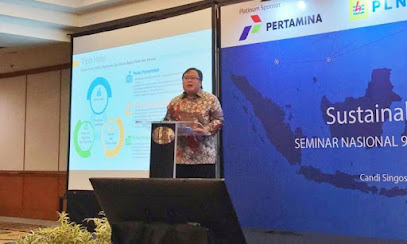Ketika Eropa mentargetkan bioeconomy-nya bisa menggerakkan ekonomi sebesar € 2 trilyun (34.000 trilyun rupiah atau 17 kali APBN Indonesia) dengan menyerap 20 juta tenaga kerja dan lebih khususnya Belanda yang luasnya kurang lebih seukuran Jawa Timur mentargetkan € 2,6-3 milyar (sekitar 50 trilyun rupiah) dengan bioeconomy-nya, Indonesia sebagai negara tropis, tanah yang luas dan subur seharusnya bisa mendongkrak ekonominya juga dengan bioeconomy.
Pendekatan dan model bioeconomy yang dikembangkan Indonesia bisa saja berbeda dengan yang dilakukan di Eropa dan di Belanda, karena potensi alamnya dan karakteristik penduduknya juga tidak sama.
Dengan penduduk mayoritas muslim sudah seharusnya Indonesia mengembangkan banyak model-model bioeconomy yang sejalan dengan nilai Islam. Hal ini karena bioeconomy juga akan terkait terkait masalah pangan dan sandang yang dalam Islam sangat jelas terkait dengan masalah halal haram. Bukan hanya itu tentu model tersebut juga dioptimasi sehingga bisa semaksimal mungkin membawa kemakmuran umat dan memberi solusi pada sejumlah masalah besar yang dihadapi.
Ekonomi Islam yang belum menjadi mainstream di negeri mayoritas Islam adalah salah satu masalah besar tersebut. Dengan banyak melakukan syirkah dan wakaf sejumlah peluang-peluang besar dalam era bioeconomy bisa dengan mudah ditangkap dan dioptimalkan.
Dengan iklim tropis, tanah luas, subur dan curah hujan tinggi, pengembangan kebun energi untuk produksi wood pellet, peternakan domba, peternakan lebah madu dan produksi arang dengan pyrolysis adalah salah satu model bioeconomy yang bisa dikembangkan.
Pyrolysis selain menghasilkan arang juga menghasilkan syngas yang bisa dikonversi menjadi listrik. Listrik berguna untuk menjalankan unit pyrolysis tersebut dan juga produksi wood pelletnya. Limbah pabrik sawit seperti tandan kosong kelapa sawit maupun limbah perkebunan kelapa sawit yakni pelepah bisa digunakan untuk bahan baku pyrolysis tersebut.
Sampah kota juga bisa dijadikan bahan baku untuk pirolisis tersebut. Jika tidak maka sejumlah atau sebagian kayu dari panen kebun energi bisa digunakan untuk bahan baku pyrolysis tersebut. Produk lainnya dari pyrolysis yakni arang, biooil dan pyroligneous acid (liquid smoke).
Semua produk tersebut memiliki nilai ekonomi yang tinggi dan bisa diupgrade untuk menjadi sejumlah produk turunan. Seberapa panjang mata rantai industri juga tergantung dari keekonomian industri tersebut. Semakin panjang rantai industri semestinya akan memberi nilai tambah semakin besar dan kontribusi yang besar juga pada bioeconomy.
Bagaimana bisa merealisasikan bioeconomy model di atas? Tentu pekerjaan besar untuk merealisasikan bioeconmy model tersebut karena mengintegrasikan beberapa unit sehingga menjadi siklus tertutup. Entry point bisa dimulai dari salah satu unit bisnis yang lebih mudah dilakukan.
Penggembalaan domba atau Penggembalaan domba dan sapi (mixed grazing) bisa jadi entry point termudah, karena bagi umat Islam juga mendukung untuk penegakan syar'i at Islam, yakni syar'i at qurban setiap 10 Dzulhijah.
Selain itu juga berarti akan meningkatkan produksi daging dalam negeri. Penggembalaan rotasi (rotation grazing) adalah pola penggembalaan yang efektif dan efisien, apalagi dibandingkan pola penggembalaan tradisional, yakni penggembalaan kontinyu (continous grazing).
Setelah penggembalaan tersebut, selanjutnya diikuti dengan produksi wood pellet dari kebun energi, yang limbah daun-daunnya yang juga kaya kandungan protein juga akan sebagai pakan tambahan bagi hewan-hewan ternak tersebut. Kotoran ternak dari kandangnya bisa digunakan untuk pupuk di kebun energi, sedangkan padang penggembalaan sendiri telah mendapatkan pupuk sewaktu penggembalaan dilakukan di area tersebut.
Terakhir yakni mengintegrasikan unit pyrolysis yang tujuan utamanya untuk produksi listrik untuk mencukupi operasinal pabrik wood pellet. Mata rantai industri bisa dikembangkan lebih panjang dengan menggunakan bahan baku (feedstock) dari hasil samping proses pyrolysis tersebut.
Ketika model ini bisa dibuat dan terbukti memberi keuntungan dan manfaat yang besar, maka selanjutnya model tersebut tinggal diperbanyak dan diperbesar. Ketika hand phone layar sentuh pertama kali dikenalkan maka banyak pihak yang skeptis dan mencemooh konsep tersebut untuk bisa digunakan secara masal, tetapi hari ini sebagian besar hand phone dan gadget menggunakan layar sentuh untuk mengoperasikannya.
Orang-orang baru tertarik dan berbondong-bondong menjadi follower ketika telah melihat bukti. Tetapi siapa yang mau menjadi pioneer dan memberi bukti kepada orang-orang itu? Tentu bukan orang sembarangan dan hanya sangat sedikit orang yang mau dan mampu melakukannya. Steve Jobs, menunjukkan bahwa handphone layar sentuh Apple bisa handal digunakan dan memberi bukti bagi orang-orang. Ungkapan Steve Jobs yang terkenal yakni
“ People do not know what they want until you show it to them – masyarakat tidak tahu apa yang mereka inginkan sampai Anda tunjukkan kepada mereka !”.
Contoh di dunia perkebunan akan lebih dekat dengan bioeconomy model. Ketika Belanda membawa empat biji sawit lalu tumbuh menjadi pohon sawit lalu dibuatlah perkebunan kecil, lalu semakin luas karena banyak ditiru dan dikembangkan ke banyak tempat. Kondisi tersebut terjadi karena usaha tersebut bisa membuktikan memberi keuntungan menarik.
Demikian juga dengan pengembangan bioeconomy. Semakin terbukti memberi keuntungan dan manfaat lebih baik, tentu semakin menarik untuk diterapkan dan dikembangkan ke banyak lokasi, bahkan tidak hanya di Indonesia saja tetapi bisa juga di Malaysia dan khususnya negara-negara muslim lainnya.
Sumber :
http://inovasibiomasa.blogspot.com/2018/04/bioeconomy-model-untuk-indonesia.html
















